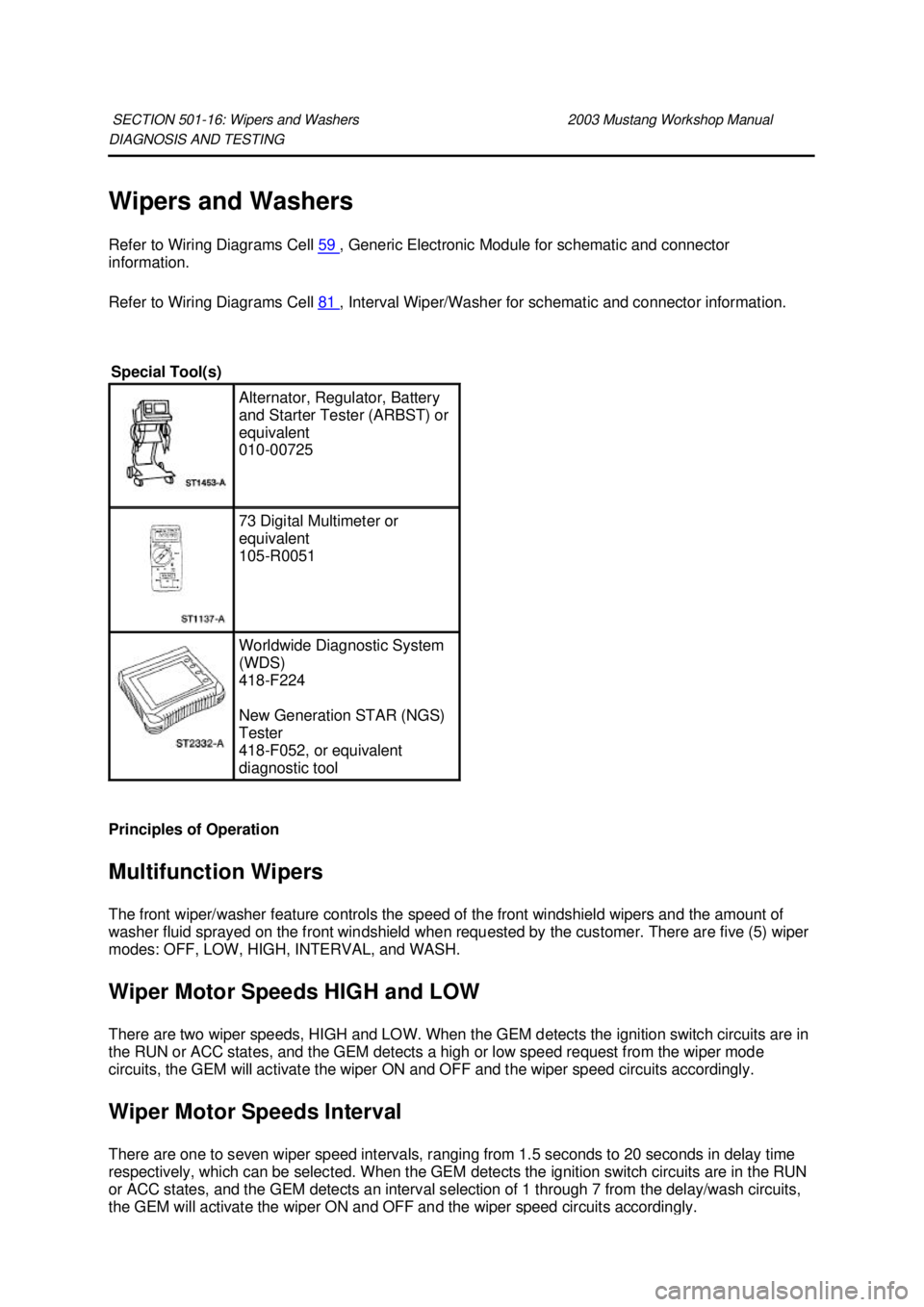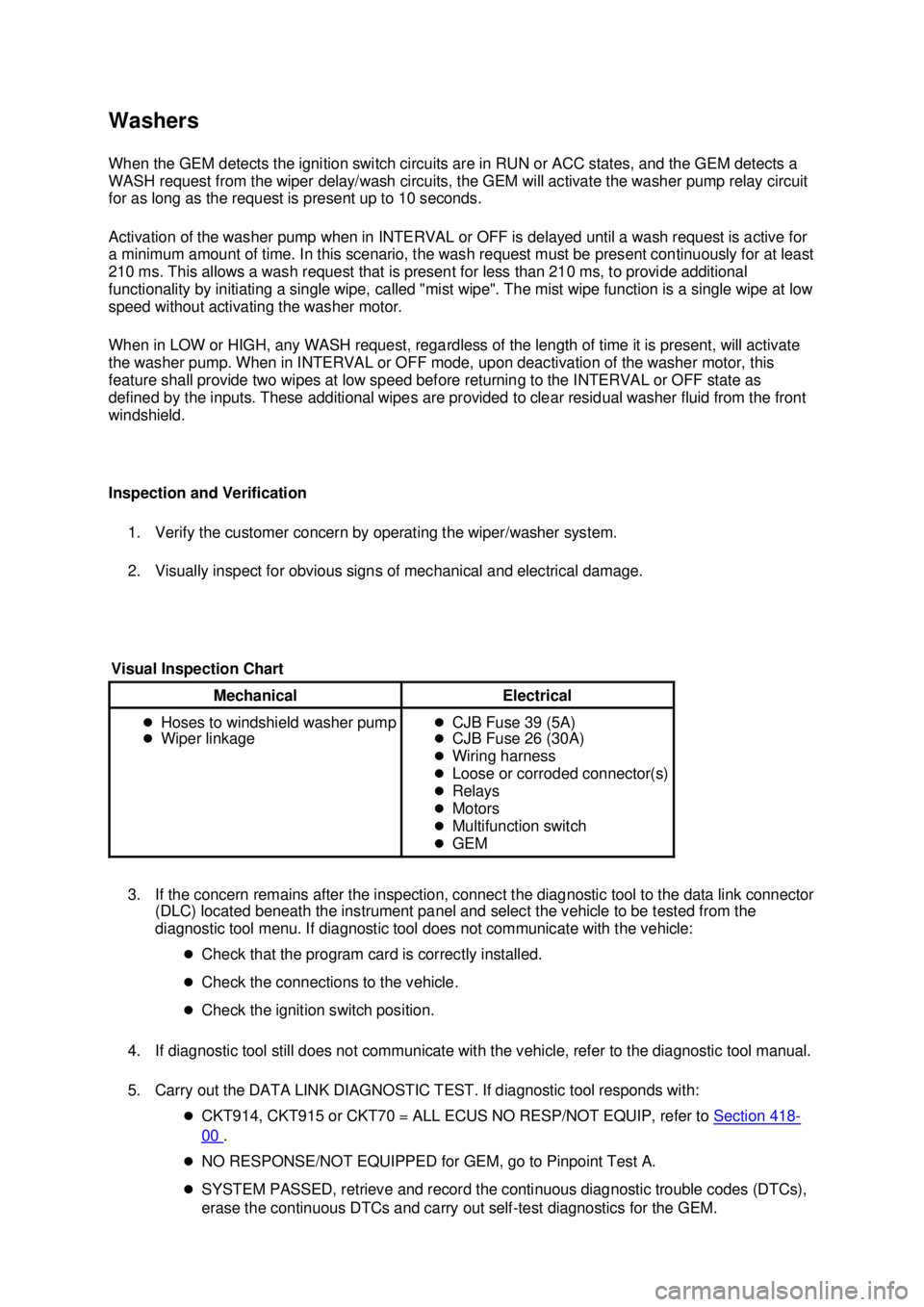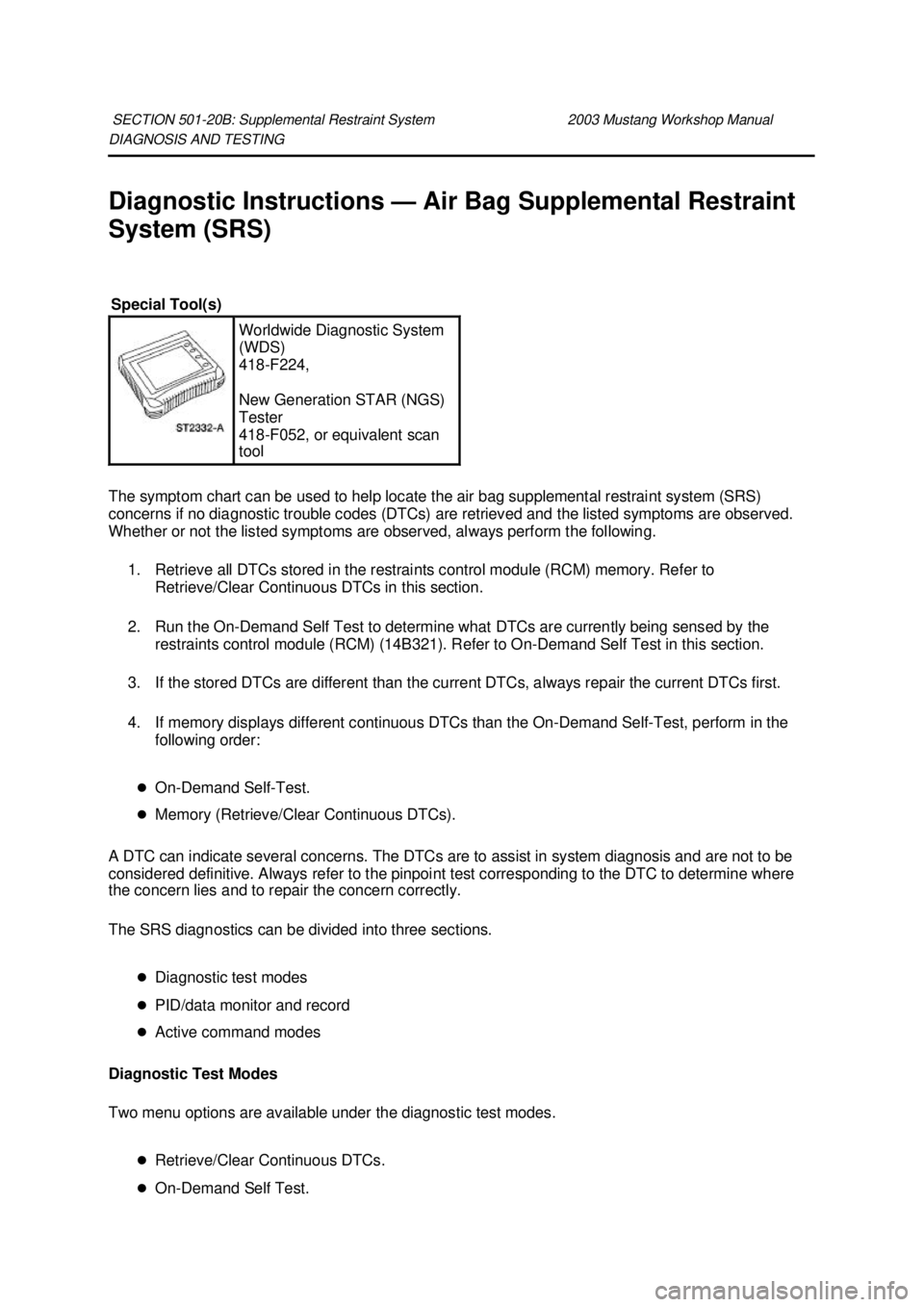Page 3868 of 4378

DIAGNOSIS AND TESTING
Wipers and Washers
Refer to Wiring Diagrams Cell
59 , Generic Electronic Module for schematic and connector
information.
Refer to Wiring Diagrams Cell 81 , Interval Wiper/Washer for schematic and connector information.
Principles of Operation
Multifunction Wipers
The front wiper/washer feature controls the speed of the front windshield wipers and the amount of
washer fluid sprayed on the front windshield when requested by the customer. There are five (5) wiper
modes: OFF, LOW, HIGH, INTERVAL, and WASH.
Wiper Motor Speeds HIGH and LOW
There are two wiper speeds, HIGH and LOW. When the GEM detects the ignition switch circuits are in
the RUN or ACC states, and the GEM detects a high or low speed request from the wiper mode
circuits, the GEM will activate the wiper ON and OFF and the wiper speed circuits accordingly.
Wiper Motor Speeds Interval
There are one to seven wiper speed intervals, ranging from 1.5 seconds to 20 seconds in delay time
respectively, which can be selected. When the GEM detects the ignition switch circuits are in the RUN
or ACC states, and the GEM detects an interval selection of 1 through 7 from the delay/wash circuits, the GEM will activate the wiper ON and OFF and the wiper speed circuits accordingly. SECTION 501-
16: Wipers and Washers 2003 Mustang Workshop Manual Special Tool(s)
Alternator, Regulator, Battery
and Starter Tester (ARBST) or
equivalent
010-
00725 73 Digital Multimeter or
equivalent
105-
R0051 Worldwide Diagnostic System
(WDS)
418-
F224
New Generation STAR (NGS)
Tester
418- F052, or equivalent
diagnostic tool �K�l�j . 1 �b�a
202003 Mustang Workshop Manual
18. 11. 2011file:///C:/Ford/2000 - 2004/tsocache/SHEF_5108/S3B~us~en~ ...
Page 3869 of 4378

Washers
When the GEM detects the ignition switch circuits are in RUN or ACC states, and the GEM detects a
WASH request from the wiper delay/wash circuits, the GEM will activate the washer pump relay circuit
for as long as the request is present up to 10 seconds.
Activation of the washer pump when in INTERVAL or OFF is delayed until a wash request is active for
a minimum amount of time. In this scenario, the wash request must be present continuously for at least
210 ms. This allows a wash request that is present for less than 210 ms, to provide additional
functionality by initiating a single wipe, called "mist wipe". The mist wipe function is a single wipe at low
speed without activating the washer motor.
When in LOW or HIGH, any WASH request, regardless of the length of time it is present, will activate
the washer pump. When in INTERVAL or OFF mode, upon deactivation of the washer motor, this
feature shall provide two wipes at low speed before returning to the INTERVAL or OFF state as
defined by the inputs. These additional wipes are provided to clear residual washer fluid from the front
windshield.
Inspection and Verification
1. Verify the customer concern by operating the wiper/washer system.
2. Visually inspect for obvious signs of mechanical and electrical damage.
3. If the concern remains after the inspection, connect the diagnostic tool to the data link connector (DLC) located beneath the instrument panel and select the vehicle to be tested from the
diagnostic tool menu. If diagnostic tool does not communicate with the vehicle:
�zCheck that the program card is correctly installed.
�z Check the connections to the vehicle.
�z Check the ignition switch position.
4. If diagnostic tool still does not communicate with the vehicle, refer to the diagnostic tool manual.
5. Carry out the DATA LINK DIAGNOSTIC TEST. If diagnostic tool responds with: �zCKT914, CKT915 or CKT70 = ALL ECUS NO RESP/NOT EQUIP, refer to Section 418 -
00 .
�z NO RESPONSE/NOT EQUIPPED for GEM, go to Pinpoint Test A.
�z SYSTEM PASSED, retrieve and record the continuous diagnostic trouble codes (DTCs),
erase the continuous DTCs and carry out self- test diagnostics for the GEM.
Visual Inspection Chart Mechanical Electrical
�z
Hoses to windshield washer pump
�z Wiper linkage �z
CJB Fuse 39 (5A)
�z CJB Fuse 26 (30A)
�z Wiring harness
�z Loose or corroded connector(s)
�z Relays
�z Motors
�z Multifunction switch
�z GEM �K�l�j . 2 �b�a
202003 Mustang Workshop Manual
18. 11. 2011file:///C:/Ford/2000 - 2004/tsocache/SHEF_5108/S3B~us~en~ ...
Page 4023 of 4378

DIAGNOSIS AND TESTING
Diagnostic Instructions —
Air Bag Supplemental Restraint
System (SRS)
The symptom chart can be used to help locate the air bag supplemental restraint system (SRS)
concerns if no diagnostic trouble codes (DTCs) are retrieved and the listed symptoms are observed.
Whether or not the listed symptoms are observed, always perform the following.
1. Retrieve all DTCs stored in the restraints control module (RCM) memory. Refer to Retrieve/Clear Continuous DTCs in this section.
2. Run the On- Demand Self Test to determine what DTCs are currently being sensed by the
restraints control module (RCM) (14B321). Refer to On- Demand Self Test in this section.
3. If the stored DTCs are different than the current DTCs, always repair the current DTCs first.
4. If memory displays different continuous DTCs than the On- Demand Self-Test, perform in the
following order:
�z On- Demand Self- Test.
�z Memory (Retrieve/Clear Continuous DTCs).
A DTC can indicate several concerns. The DTCs are to assist in system diagnosis and are not to be
considered definitive. Always refer to the pinpoint test corresponding to the DTC to determine where
the concern lies and to repair the concern correctly.
The SRS diagnostics can be divided into three sections.
�zDiagnostic test modes
�z PID/data monitor and record
�z Active command modes
Diagnostic Test Modes
Two menu options are available under the diagnostic test modes.
�zRetrieve/Clear Continuous DTCs.
�z On- Demand Self Test.
SECTION 501-
20B: Supplemental Restraint System 2003 Mustang Workshop Manual Special Tool(s)
Worldwide Diagnostic System
(WDS)
418-
F224,
New Generation STAR (NGS)
Tester
418- F052, or equivalent scan
tool �K�l�j . 1 �b�a
52003 Mustang Workshop Manual
18. 11. 2011file:///C:/Ford/2000 - 2004/tsocache/SHEF_5108/S3B~us~en~ ...